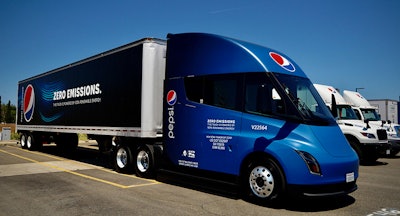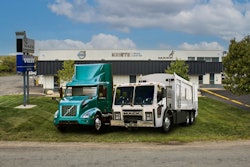
The much-hyped Tesla Semi finally saw some real-world performance data drop into the public eye. After nearly six years of anticipation, the trucking industry can now judge if Elon Musk's "most badass rig on the road" lives up to the hype.
Currently, the Tesla Semi has only one customer -- Pepsico. Though often spotted on the road out West, neither Pepsi nor Tesla have shed any light on how the truck performs in real-world settings, until now.
[Related: Is Tesla's Semi really 'most badass rig on the road'?]
As part of the North American Council for Freight Efficiency's Run on Less program, Pepsi's Sacramento, California, location has reported mileage, stops, speed and charging details on three Semis over the last three days. For a total of 18 days, the trucks, along with 20-some other EV applications in a variety of other use cases and settings, will report their stats on the Run on Less website.
So far, numbers indicate that Tesla's claims of a 500-mile range at 81,000 pounds might not be that far off from the truth.
"For those of us following the Tesla Semi for years, the hype has always vastly exceeded the ability to evaluate whether the hype was real," said Dave Mullaney, Principal at the Rocky Mountain Institute, in a post on LinkedIn. "There was no data on anything, just some big claims from Tesla, which in my experience tend to be true if you give them long enough, but you never really know how long 'long enough' would be."
Tesla Semi's performance stats
 This partial view of the Run on Less dashboard shows some quick stats for the Tesla Semi #3, including a rather impressive single-day milage total of 545.Run on Less
This partial view of the Run on Less dashboard shows some quick stats for the Tesla Semi #3, including a rather impressive single-day milage total of 545.Run on Less
On the Run on Less website, users can view the miles traveled by all three Semis each day.
Day one saw Semi 1 travel 416 miles, stopping just once for about 20 minutes to charge from 17.5% battery up to 30% after traveling 335 miles, and then finally ending up with 17.5% left at the conclusion of the day. Semi 2 put up 295 miles before getting to a 21% "state of charge," or SOC, and then restarted in the afternoon for a total of 376 miles.
"This truck may have been loaded more heavily as it showed a somewhat shorter range than Truck 1," Mullaney wrote. More on the range v. load dynamic later.
Finally, Semi 3 cut it close with 377 miles leaving the battery near flat at just 1.6%, after running at an average of 62 mph. Charging for three hours or so, Semi 3 then racked up another 165 miles for a Day one total of 545.
Keep in mind, a recent study shown to Congress indicated 6.5 hours of drive time a day as a real-world average for a particular subset of operators, out of a possible 11. Assume 65 mph over 6.5 hours and that's just 430 or so miles a day run across an available 14 hours of possible duty time, something that's possible within the Semi's demonstrated range, and comfortable with some time spent charging during the day.
On Day two, the Semi 2 posted even better numbers, hitting 794 total miles with just under two hours spent charging.
Mike Roeth, Executive Director of NACFE, gave us further details on the operational mechanics of the Semi, specifically on how it handles under a load.
Tesla Semi performance while loaded
 Video from the Tesla Semi Delivery Event shows the Semi loaded with concrete barriers blowing past other trucks on the steep grades of California's Donner Pass.Tesla
Video from the Tesla Semi Delivery Event shows the Semi loaded with concrete barriers blowing past other trucks on the steep grades of California's Donner Pass.Tesla
First off, let's address the issue of weight. The Tesla Semi has been seen blowing past diesel trucks on the road, leaving drivers to question if, or how much, these EVs are hauling. Tesla has not announced the official weight of the Semi, but Class 8 EVs do have a pass on going 2,000 pounds over the 80,000 limit, which Tesla indicates the Semi will use every bit of.
In Sacramento with Pepsi, "we’re tracking the beverage" shipments, said Roeth. "It's impressive, a fairly heavy haul at nearly 80,000 pounds. It goes to one location and drops off soda, but maybe picks up some waters, goes to another location to drop off waters but pick up Gatorade," he gave as an example.
On the exact question of weight, Roeth said "we don’t really know the payload" for any given truck on any given day, but "NACFE has verified that these are fairly fully loaded when they leave and stay fairly loaded. They're not out there gaming Run on Less."
But due to the extra weight of the Semi, Roeth did note "that run yesterday is with less beverages than if it was a diesel truck," but not much less, and likely the shipments are adjusted to keep the total weight under 82,000.
Additionally, Roeth said the Semis have an advantage in charging. On its own proprietary chargers, which aren't yet widespread, it "charges incredibly fast, two to four times faster than any other available heavy truck."
Looking at some of the charge times and amounts from the first three days of testing seems to bear that out -- the rig sometimes picks up about 20% in 30 minutes.
"To be blunt, Tesla has built and sold 36 Semis," said Roeth. "They're not nearly in production yet, and they haven't really worked through with a lot of utilities how to handle this fast charging."
Furthermore, weather stats on the Run on Less website shows these runs mostly occurred on cool mornings, tailing off on hot afternoons, and also that the Semi didn't face any major winds or rains, something that real-world diesel truckers contend with daily.
Yet Roeth still seemed to think this would open up a wide variety of tangible use cases for trucking, even rivaling diesel "if you're able to get back to base." Follow along the Tesla Semis and other EVs on Run On Less' website and stay tuned for a Monday live presser on LinkedIn for more information on the first-ever real look at the Semi's performance.











